2018 Hyundai Elantra child restraint
[x] Cancel search: child restraintPage 47 of 526
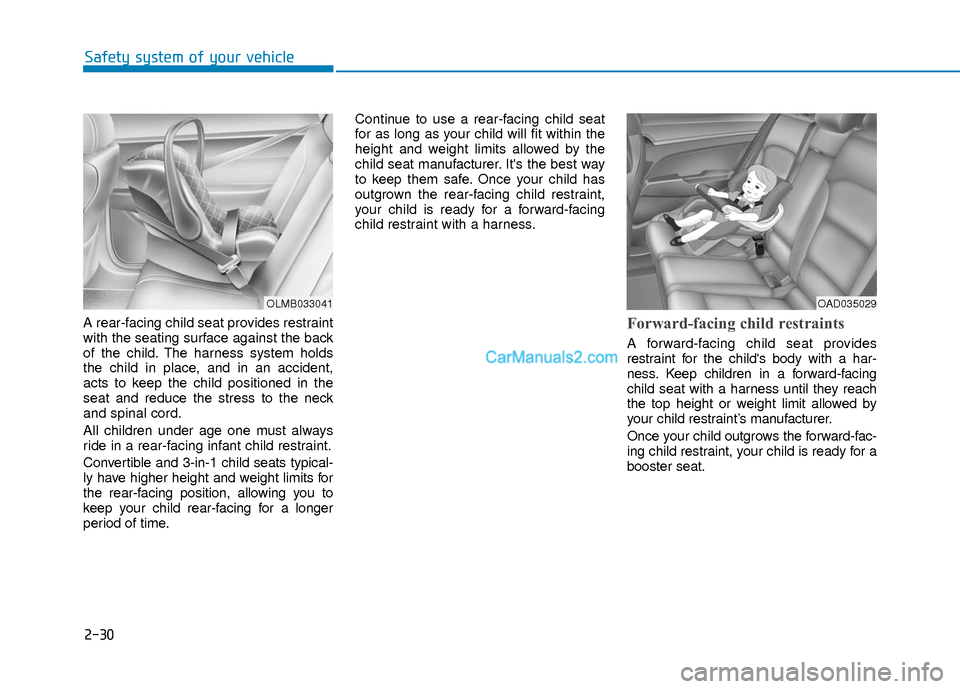
2-30
Safety system of your vehicle
A rear-facing child seat provides restraint
with the seating surface against the back
of the child. The harness system holds
the child in place, and in an accident,
acts to keep the child positioned in the
seat and reduce the stress to the neck
and spinal cord.
All children under age one must always
ride in a rear-facing infant child restraint.
Convertible and 3-in-1 child seats typical-
ly have higher height and weight limits for
the rear-facing position, allowing you to
keep your child rear-facing for a longer
period of time.Continue to use a rear-facing child seat
for as long as your child will fit within the
height and weight limits allowed by the
child seat manufacturer. It's the best way
to keep them safe. Once your child has
outgrown the rear-facing child restraint,
your child is ready for a forward-facing
child restraint with a harness.Forward-facing child restraints
A forward-facing child seat provides
restraint for the child's body with a har-
ness. Keep children in a forward-facing
child seat with a harness until they reach
the top height or weight limit allowed by
your child restraint’s manufacturer.
Once your child outgrows the forward-fac-
ing child restraint, your child is ready for a
booster seat.
OLMB033041OAD035029
Page 48 of 526
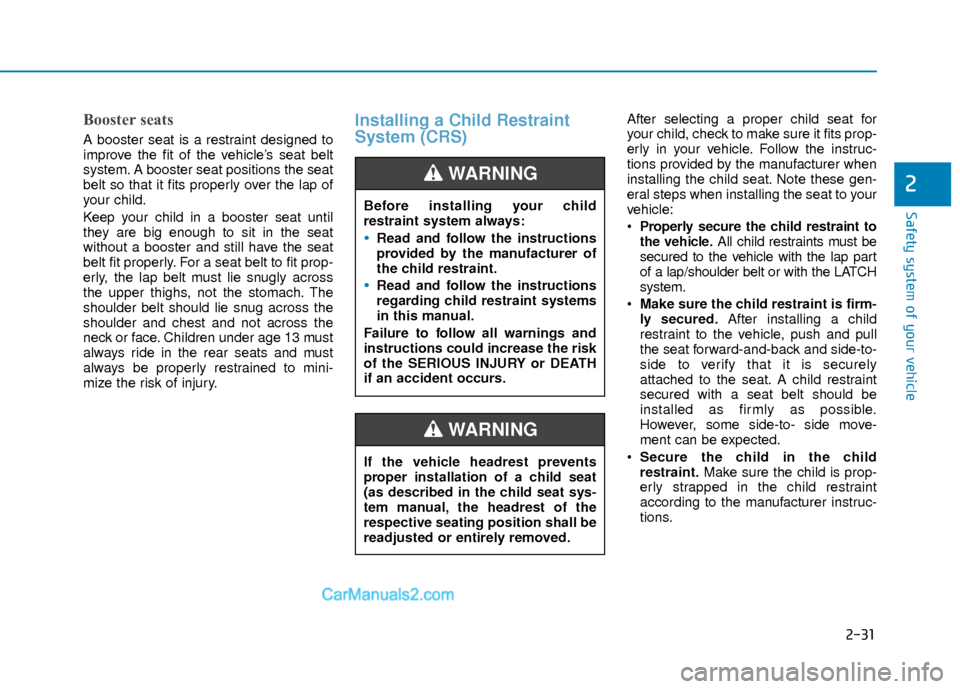
2-31
Safety system of your vehicle
2
Booster seats
A booster seat is a restraint designed to
improve the fit of the vehicle’s seat belt
system. A booster seat positions the seat
belt so that it fits properly over the lap of
your child.
Keep your child in a booster seat until
they are big enough to sit in the seat
without a booster and still have the seat
belt fit properly. For a seat belt to fit prop-
erly, the lap belt must lie snugly across
the upper thighs, not the stomach. The
shoulder belt should lie snug across the
shoulder and chest and not across the
neck or face. Children under age 13 must
always ride in the rear seats and must
always be properly restrained to mini-
mize the risk of injury.
Installing a Child Restraint
System (CRS)After selecting a proper child seat for
your child, check to make sure it fits prop-
erly in your vehicle. Follow the instruc-
tions provided by the manufacturer when
installing the child seat. Note these gen-
eral steps when installing the seat to your
vehicle:
Properly secure the child restraint to
the vehicle.All child restraints must be
secured to the vehicle with the lap part
of a lap/shoulder belt or with the LATCH
system.
Make sure the child restraint is firm-
ly secured. After installing a child
restraint to the vehicle, push and pull
the seat forward-and-back and side-to-
side to verify that it is securely
attached to the seat. A child restraint
secured with a seat belt should be
installed as firmly as possible.
However, some side-to- side move-
ment can be expected.
Secure the child in the child
restraint. Make sure the child is prop-
erly strapped in the child restraint
according to the manufacturer instruc-
tions.
Before installing your child
restraint system always:Read and follow the instructions
provided by the manufacturer of
the child restraint.
Read and follow the instructions
regarding child restraint systems
in this manual.
Failure to follow all warnings and
instructions could increase the risk
of the SERIOUS INJURY or DEATH
if an accident occurs.
WARNING
If the vehicle headrest prevents
proper installation of a child seat
(as described in the child seat sys-
tem manual, the headrest of the
respective seating position shall be
readjusted or entirely removed.
WARNING
Page 49 of 526
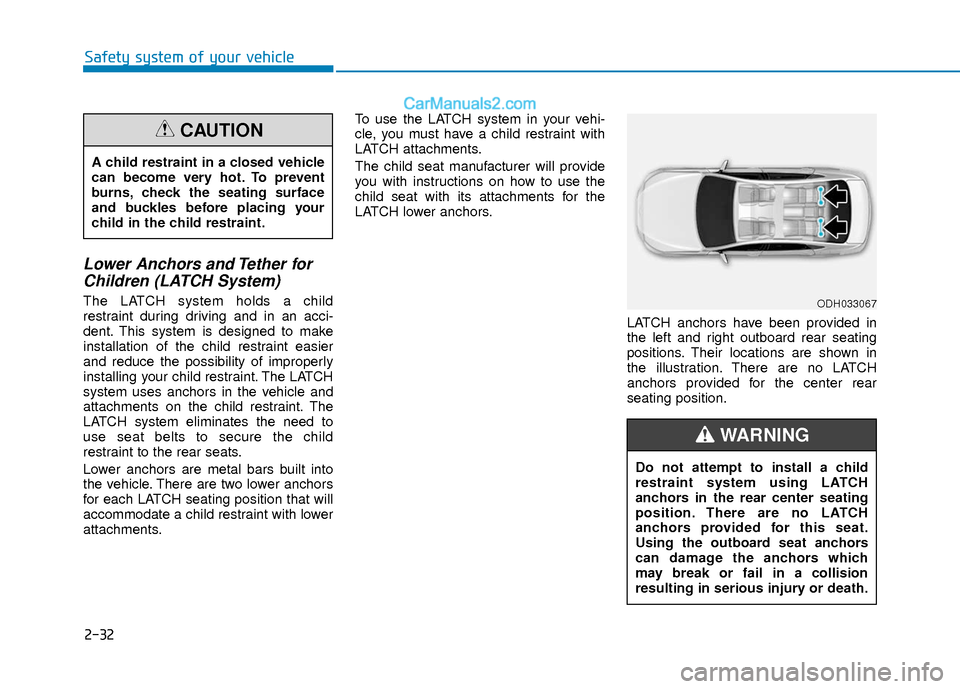
2-32
Safety system of your vehicle
Lower Anchors and Tether forChildren (LATCH System)
The LATCH system holds a child
restraint during driving and in an acci-
dent. This system is designed to make
installation of the child restraint easier
and reduce the possibility of improperly
installing your child restraint. The LATCH
system uses anchors in the vehicle and
attachments on the child restraint. The
LATCH system eliminates the need to
use seat belts to secure the child
restraint to the rear seats.
Lower anchors are metal bars built into
the vehicle. There are two lower anchors
for each LATCH seating position that will
accommodate a child restraint with lower
attachments. To use the LATCH system in your vehi-
cle, you must have a child restraint with
LATCH attachments.
The child seat manufacturer will provide
you with instructions on how to use the
child seat with its attachments for the
LATCH lower anchors.
LATCH anchors have been provided in
the left and right outboard rear seating
positions. Their locations are shown in
the illustration. There are no LATCH
anchors provided for the center rear
seating position.
A child restraint in a closed vehicle
can become very hot. To prevent
burns, check the seating surface
and buckles before placing your
child in the child restraint.
CAUTION
ODH033067
Do not attempt to install a child
restraint system using LATCH
anchors in the rear center seating
position. There are no LATCH
anchors provided for this seat.
Using the outboard seat anchors
can damage the anchors which
may break or fail in a collision
resulting in serious injury or death.
WARNING
Page 50 of 526

2-33
Safety system of your vehicle
2
The lower anchor position indicator sym-
bols are located on the left and right rear
seat backs to identify the position of the
lower anchors in your vehicle (see arrows
in illustration).
The LATCH anchors are located between
the seatback and the seat cushion of the
rear seat left and right outboard seating
positions.
Securing a child restraint withthe LATCH anchors system
To install a LATCH-compatible child
restraint in either of the rear outboard
seating positions:
1. Move the seat belt buckle away from
the lower anchors.
2. Move any other objects away from the anchors that could prevent a secure
connection between the child restraint
and the lower anchors.
3. Place the child restraint on the vehicle seat, then attach the seat to the lower
anchors according to the instructions
provided by the child restraint manu-
facturer.
4. Follow the child restraint instructions for properly adjusting and tightening
the lower attachments on the child
restraint to the lower anchors.
OAD035032
Lower Anchor
Position Indicator
Lower Anchor
Take the following precautions
when using the LATCH system:
Read and follow all installation
instructions provided with your
child restraint system.
To prevent the child from reach-
ing and taking hold of unretract-
ed seat belts, buckle all unused
rear seat belts and retract the
seat belt webbing behind the
child. Children can be strangled if
a shoulder belt becomes
wrapped around their neck and
the seat belt tightens.
NEVER attach more than one
child restraint to a single anchor.
This could cause the anchor or
attachment to come loose or
break.
Always have the LATCH system
inspected by your authorized
HYUNDAI dealer after an acci-
dent. An accident can damage
the LATCH system and may not
properly secure the child
restraint.
WARNING
Page 51 of 526
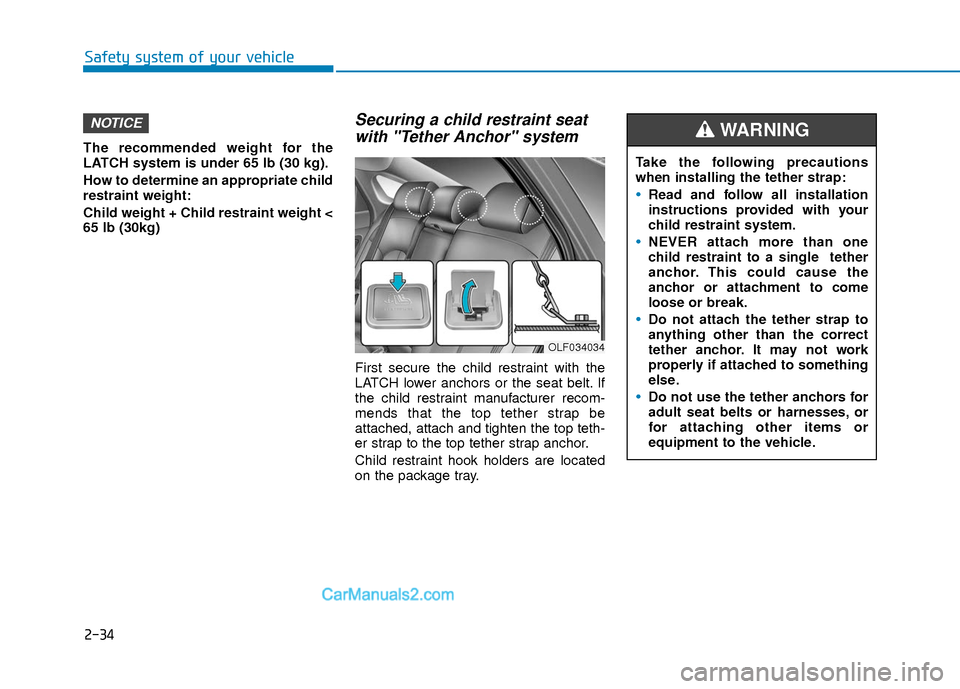
2-34
Safety system of your vehicle
The recommended weight for the
LATCH system is under 65 lb (30 kg).
How to determine an appropriate child
restraint weight:
Child weight + Child restraint weight <
65 lb (30kg)
Securing a child restraint seatwith "Tether Anchor" system
First secure the child restraint with the
LATCH lower anchors or the seat belt. If
the child restraint manufacturer recom-
mends that the top tether strap be
attached, attach and tighten the top teth-
er strap to the top tether strap anchor.
Child restraint hook holders are located
on the package tray.
NOTICE
OLF034034
Take the following precautions
when installing the tether strap:
Read and follow all installation
instructions provided with your
child restraint system.
NEVER attach more than one
child restraint to a single tether
anchor. This could cause the
anchor or attachment to come
loose or break.
Do not attach the tether strap to
anything other than the correct
tether anchor. It may not work
properly if attached to something
else.
Do not use the tether anchors for
adult seat belts or harnesses, or
for attaching other items or
equipment to the vehicle.
WARNING
Page 52 of 526

2-35
Safety system of your vehicle
2
To install the tether anchor:
1. Route the child restraint tether strapover the child restraint seatback.
Route the tether strap under the head
restraint and between the head
restraint posts, or route the tether
strap over the top of the vehicle seat-
back. Make sure the strap is not twist-
ed.
2. Connect the tether strap hook to the tether anchor, then tighten the tether
strap according to the child seat man-
ufacturer’s instructions to firmly
secure the child restraint to the seat.
3. Check that the child restraint is securely attached to the seat by push-
ing and pulling the seat forward-and-
back and side-to-side.
Securing a child restraint withlap/shoulder belt
When not using the LATCH system, all
child restraints must be secured to a
vehicle rear seat with the lap part of a
lap/shoulder belt.
Automatic locking mode
Since all passenger seat belts move
freely under normal conditions and only
lock under extreme or emergency condi-
tions (emergency locking mode), you
must manually pull the seat belt all the
way out to shift the retractor to the
"Automatic Locking" mode to secure a
child restraint.
The "Automatic Locking" mode will help
prevent the normal movement of the
child in the vehicle from causing the seat
belt to loosen and compromise the child
restraint system. To secure a child
restraint system, use the following proce-
dure.
OLF034035
ALWAYS place a rear-facing child
restraint in the rear seat of the vehi-
cle.
Placing a rear-facing child restraint
in the front seat can result in seri-
ous injury or death if the child
restraint is struck by an inflating air
bag.
WARNING
OLMB033044
Page 53 of 526
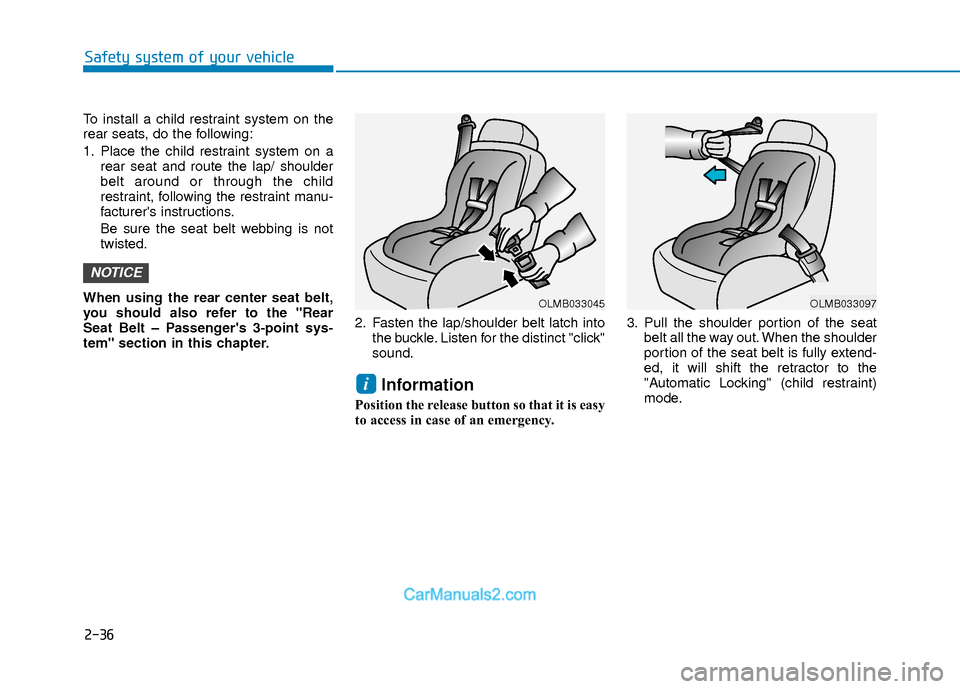
2-36
Safety system of your vehicle
To install a child restraint system on the
rear seats, do the following:
1. Place the child restraint system on arear seat and route the lap/ shoulder
belt around or through the child
restraint, following the restraint manu-
facturer's instructions.
Be sure the seat belt webbing is not
twisted.
When using the rear center seat belt,
you should also refer to the "Rear
Seat Belt – Passenger's 3-point sys-
tem" section in this chapter. 2. Fasten the lap/shoulder belt latch into
the buckle. Listen for the distinct "click"
sound.
Information
Position the release button so that it is easy
to access in case of an emergency. 3. Pull the shoulder portion of the seat
belt all the way out. When the shoulder
portion of the seat belt is fully extend-
ed, it will shift the retractor to the
"Automatic Locking" (child restraint)
mode.
i
NOTICE
OLMB033045OLMB033097
Page 54 of 526
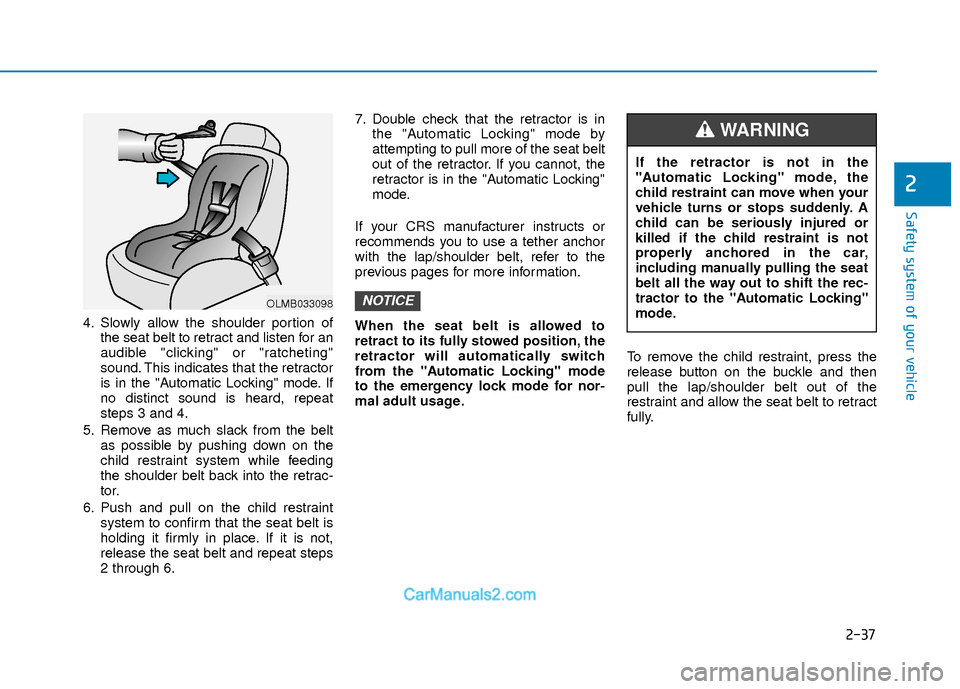
2-37
Safety system of your vehicle
2
4. Slowly allow the shoulder portion ofthe seat belt to retract and listen for an
audible "clicking" or "ratcheting"
sound. This indicates that the retractor
is in the "Automatic Locking" mode. If
no distinct sound is heard, repeat
steps 3 and 4.
5. Remove as much slack from the belt as possible by pushing down on the
child restraint system while feeding
the shoulder belt back into the retrac-
tor.
6. Push and pull on the child restraint system to confirm that the seat belt is
holding it firmly in place. If it is not,
release the seat belt and repeat steps
2 through 6. 7. Double check that the retractor is in
the "Automatic Locking" mode by
attempting to pull more of the seat belt
out of the retractor. If you cannot, the
retractor is in the "Automatic Locking"
mode.
If your CRS manufacturer instructs or
recommends you to use a tether anchor
with the lap/shoulder belt, refer to the
previous pages for more information.
When the seat belt is allowed to
retract to its fully stowed position, the
retractor will automatically switch
from the "Automatic Locking" mode
to the emergency lock mode for nor-
mal adult usage. To remove the child restraint, press the
release button on the buckle and then
pull the lap/shoulder belt out of the
restraint and allow the seat belt to retract
fully.
NOTICEOLMB033098
If the retractor is not in the
"Automatic Locking" mode, the
child restraint can move when your
vehicle turns or stops suddenly. A
child can be seriously injured or
killed if the child restraint is not
properly anchored in the car,
including manually pulling the seat
belt all the way out to shift the rec-
tractor to the "Automatic Locking"
mode.
WARNING